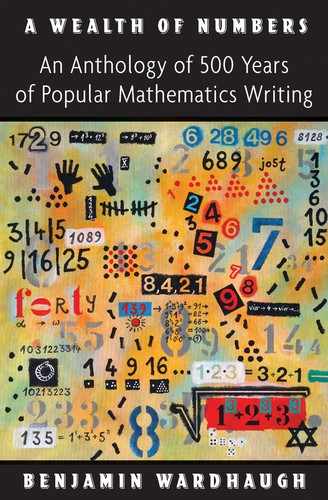Book Description
Despite what we may sometimes imagine, popular mathematics writing didn't begin with Martin Gardner. In fact, it has a rich tradition stretching back hundreds of years. This entertaining and enlightening anthology--the first of its kind--gathers nearly one hundred fascinating selections from the past 500 years of popular math writing, bringing to life a little-known side of math history. Ranging from the late fifteenth to the late twentieth century, and drawing from books, newspapers, magazines, and websites, A Wealth of Numbers includes recreational, classroom, and work mathematics; mathematical histories and biographies; accounts of higher mathematics; explanations of mathematical instruments; discussions of how math should be taught and learned; reflections on the place of math in the world; and math in fiction and humor.
Featuring many tricks, games, problems, and puzzles, as well as much history and trivia, the selections include a sixteenth-century guide to making a horizontal sundial; "Newton for the Ladies" (1739); Leonhard Euler on the idea of velocity (1760); "Mathematical Toys" (1785); a poetic version of the rule of three (1792); "Lotteries and Mountebanks" (1801); Lewis Carroll on the game of logic (1887); "Maps and Mazes" (1892); "Einstein's Real Achievement" (1921); "Riddles in Mathematics" (1945); "New Math for Parents" (1966); and "PC Astronomy" (1997). Organized by thematic chapters, each selection is placed in context by a brief introduction.
A unique window into the hidden history of popular mathematics, A Wealth of Numbers will provide many hours of fun and learning to anyone who loves popular mathematics and science.
Some images inside the book are unavailable due to digital copyright restrictions.
Table of Contents
- Cover
- Half title
- Title
- Copyright
- Contents
- Preface
- 1 “Sports and Pastimes, Done by Number”: Mathematical Tricks, Mathematical Games
- 2 “Much Necessary for All States of Men”: From Arithmetic to Algebra
- 3 “A Goodly Struggle”: Problems, Puzzles, and Challenges
- 4 “Drawyng, Measuring and Proporcion”: Geometry and Trigonometry
- 5 Maps, Monsters, and Riddles: The Worlds of Mathematical Popularization
- 6 “To Ease and Expedite the Work”: Mathematical Instruments and How to Use Them
- 7 “How Fine a Mind”: Mathematicians Past
- 8 “By Plain and Practical Rules”: Mathematics at Work
- 9 “The Speedier Expedition of Their Learning”: Thoughts on Teaching and Learning Mathematics
- “To Have Their Children or Servants Instructed”
- Euclid with Algebra
- The Idea of Velocity
- Mathematical Toys
- A Mother Explains Comets
- “Geometry without Axioms”
- The Game of Logic
- Higher Mathematics for Women
- A New Aspect of Mathematical Method
- New Math for Parents
- “Merely a Formal Statement of the Way We Think”
- Turtle Fun
- 10 “So Fundamentally Useful a Science”: Reflections on Mathematics and Its Place in the World
- The Myrrour of the Worlde
- “A Very Fruitfull Praeface”
- “Geometry Is Improving Daily”
- The Fifth Element
- Of Mathematics in General
- Lineal Arithmetic
- Astronomy in New South Wales
- The Advantages of Mathematics
- Sylvester Contra Huxley
- What a Mathematical Proposition Is
- The Character of Physical Law
- Our Invisible Culture
- 11 The Mathematicians Who Never Were: Fiction and Humor
- Index
